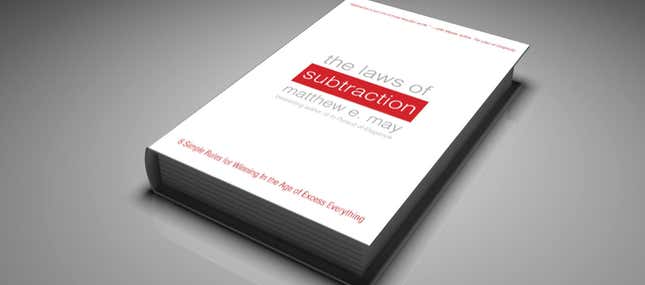Matthew E. May was invited to sit in on a planning meeting recently, serving as a facilitator to a group of executives who intended to develop a 2013 roadmap for their company. “It kept getting longer and longer,” with each idea spurring another, May said.
Instead of a clear directional plan, the group was brainstorming possibilities, new projects they might undertake. Before long, May pulled the “virtual Andon Cord,” which on some factory floors halts production line because a defect must be fixed. He needed the executives to start editing their ideas. They needed to subtract, not add more.

“There’s nothing easy about subtraction because it doesn’t come easy to us,” he said. Yet that is what May is promoting in his new book The Laws of Subtraction (McGraw Hill, $24, 224 pages). The book officially debuts Oct. 26 with a central message to Corporate America and its leaders: “When you remove just the right thing in just the right way, good things happen. …That old Michelangelo notion: He found David in the marble and removed anything that was not David.”
May, who worked as a full-time consultant to Toyota for eight years, sees his emphasis on subtraction as aligned to the lean movement, agile technology, and design thinking, but with a broader context for business people.
“It’s not about shrinking head count or reductions or right-sizing–it’s just the right things. There needs to be intelligence. There needs to be empathy,” he said in an interview.
He has adjusted his creativity consulting and coaching company accordingly, and stopped taking traditional consulting projects,”the kinds of projects that I used to take just because it was additional money.” By subtracting that work, he focuses more time where he excels–especially writing and facilitating groups.
The Laws of Subtraction contains snippets and stories from consultants, entrepreneurs and others on subtraction in their business lives. Among them are Stanford management professor Robert Sutton, Intuit’s Brad Smith–who shares his “two pizza rule” for the size of development teams–and design star Nancy Duarte, who turned down other design work so her firm could concentrate its creativity and talents on presentation design. (May often notes that he subtracted himself from the book to make room for these perspectives, which account for almost a third of the book.)
He’s been sharing stories from the book in Fast Company online, including one on how to put together a skunk works innovation team.
Managers who want to add subtraction, the author suggests, could start with “a stop doing list.” May picked up this idea from an essay by Good to Great author Jim Collins, noting: “We all try to cram far too much into our waking time.”
Some of it is stupid, wasteful, ugly or boring—and can be omitted. If you don’t know what belongs on your stop-doing list, ”ask those who are closest to you to be the mirror. They’ll tell you,” said May.
He acknowledges how difficult it is to stop doing things when the whole world seems focused on going for faster and more and bigger. “I fight it all the time. I am nowhere near a master of it, not even close,” he said.
Yet he believes it works to help people be more productive, and stand out from the crowd and all the noise. He cites Boston Consulting Group, which required its workers to take at least one night a week off, with no mobile phone, nothing. The consultants felt uncomfortable with this at first, but the results spoke loudly: “Clients liked their work better, their work product got better,” May says in a video on his sixth law: “Doing something isn’t always better than doing nothing.”
May’s “aha” moment on subtraction came in 2003 while working as a full-time adviser to Toyota. “I ran up against a project where I had absolutely no idea what to do,” he recalled. “Generally I’m an idea guy, I have a million ideas and I know what to do. But I was out of them. I was at a standstill.” He had no thought on how to proceed or what answers to provide. Then he noticed a bit of Chinese poetry by Lao Tzu taped to the back of his chair. It said: “To attain knowledge add things every day. To attain wisdom, subtract every day.”
“It woke me up,” he said. He finished the project, and started thinking about the world differently. It led him to write his first book The Elegant Solution based on Toyota’s principles for innovation, and a new career promoting creativity, simplifying and subtracting. “Subtract the obvious and add the meaningful,” he said.
